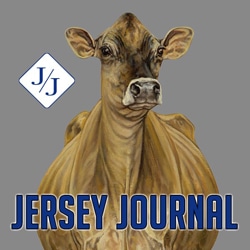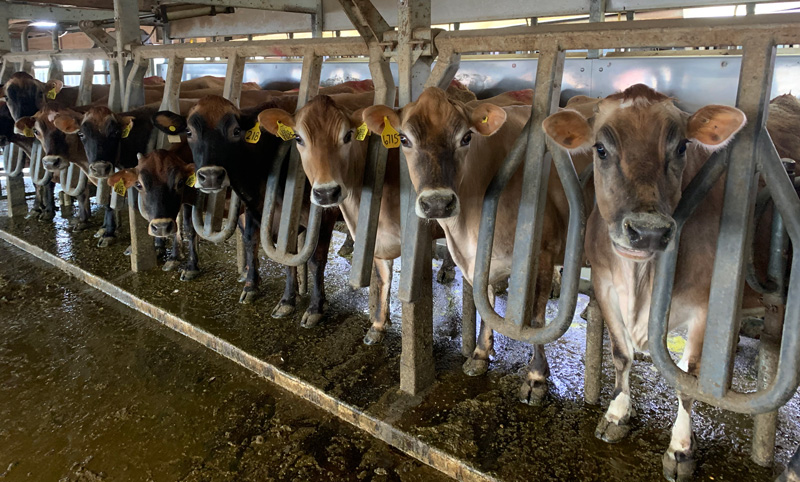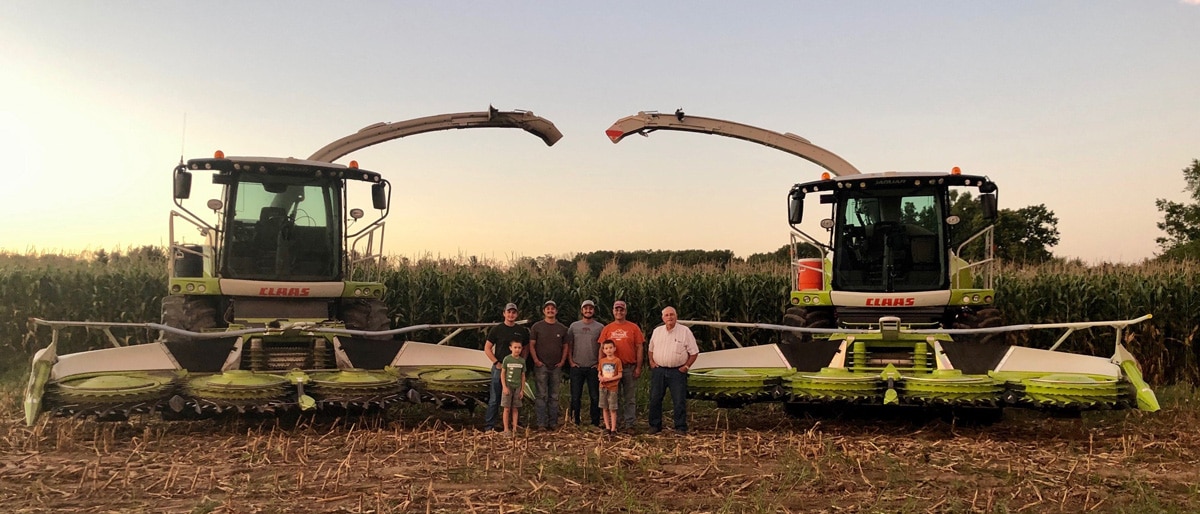Top Production Herds 2022
When the American Jersey Cattle Association (AJCA) released figures for average breed production for 2021, the news was decidedly positive from every angle. For the second straight year, per cow production climbed to a historical high for each measure of production. Equally important, component tests are higher than they have been in three decades. This means the amount of product cheesemakers can create from Jersey milk is greater than ever, reinforcing the argument that America’s brown cow is the world’s most efficient producer of dairy products.
The official lactation average now stands at 20,321 lbs. milk, 995 lbs. fat (4.9%) and 756 lbs. protein (3.72%) on a standardized mature equivalent (m.e.) basis. On a Cheddar cheese yield basis (38% moisture), average production is 2,574 lbs. The number of lactations included in the 2021 average—98,971—is up as well, an increase of 5,889 lactations over last year. Cheesemakers can now make 12.67 lbs. of product per hundredweight of Jersey milk.
Versus 2020, the measures for standardized production represent an additional 116 lbs. milk, 15 lbs. fat, 6 lbs. protein and 27 lbs. cheese yield. Cheese yield per hundredweight inched up as well, increasing from 12.61 lbs. last year.
On an actual basis, per cow production is 17,941 lbs. milk, 881 lbs. fat, 665 lbs. protein and 2,268 lbs. cheese yield. The increases are 86 lbs. milk, 12 lbs. fat, 4 lbs. protein and 20 lbs. cheese yield.
Expressed as energy corrected milk (ECM), average production for Registered Jerseys is 25,314 lbs. m.e. and 22,363 lbs. actual. Respective yield for ECM is up 278 lbs. and 214 lbs. versus 2020.
Based on statistics of the previous 10 years, the breed lactation average is projected to reach 20,831lbs. milk, 1,028 lbs. fat (4.93%) and 783 lbs. protein (3.76%) by 2025, with a cheese yield equivalent of 2,666 lbs. On an actual basis, production is projected to reach 18,413 lbs. milk, 911 lbs. fat (4.95%) and 689 lbs. protein (3.74%), with a cheese yield equivalent of 2,351 lbs. ECM is projected to be 26,111 lbs. m.e. and 23,092 lbs. actual.
Cheese makers are projected to be able to make 12.77 lbs. of product per hundredweight of Jersey milk on an actual basis by 2025. On an m.e. basis, yield is projected to be 12.80 lbs. of cheese per hundredweight.
In the annual breed production summary released by the AJCA, production is included for lactations meeting the registry minimum of Generation Count 4 and higher. Records included in the average have data collection ratings of 85 or higher. Herds identified in Jersey Journal rankings have a minimum of 10 cows.
To become better acquainted with some of the nation’s top producers, the Jersey Journal sent a questionnaire to herd owners of the top 10 herds for actual or m.e. production. Their responses are summarized below. Herds will be randomly featured over the course of the next several weeks. We hope you enjoy getting to know your peers a little better through these snapshots.
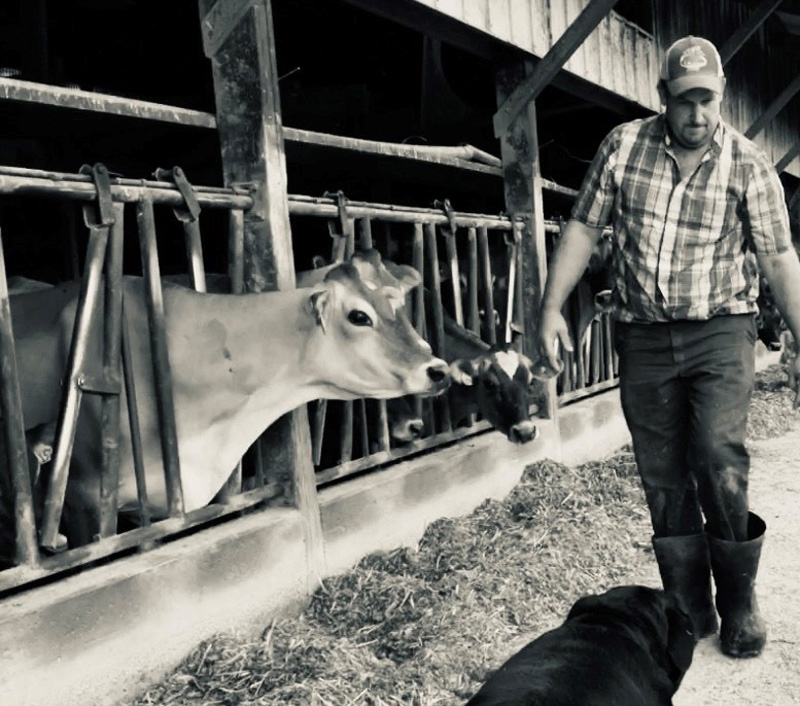
Den-Kel Jerseys LLC, Byron, NY
56 Lactations
Actual: 24,820M, 1,269F, 927P (second milk and protein, first fat)
ME: 26,029M, 1,331F, 974P (first milk, fat, protein)
Den-Kel Jerseys is owned and operated by Kip and Katie Keller and their family.
We milk about 150 cows, with 135 going through the parlor.
Milk is sold to Dairy Farmers of America. We receive both quality and protein premiums.
Cows are milked in a double-seven herringbone parlor and housed in a three-row freestall barn with headlocks. Stalls are bedded with sand. Cows are pastured roughly seven months during the year.
Submitted by Pat Brennan of Holtz-Nelson Dairy Consultants LLC. Den-Kel Jerseys a top production herd because the Kellers pay attention to details. They can do this because they keep things simple and consistent. The Kellers breed a high genetic herd and take exceptional care of calves and heifers. They are well grown and healthy, which enables first lactation heifers to be high performers from the start. Each lactation is set up for success by excellent transition cow management, which includes a low energy, negative DCAD diet.
The Kellers work with their crops team to put up quality forages. A timely harvest yields high protein levels in hay and best utilizes starch and energy in corn silage, with high fiber digestibility year after year. Forages are well packed and stored in bunk silos, resulting in excellent fermentation and stability.
With this sound base, their nutritionist can prescribe a high forage base of corn silage, haylage and straw, with ground corn and soybean meal, supplemented with heat treated proteins that contain amino acids, minerals, and vitamins. The ration achieves high fat and protein while also keeping cows healthy.
Den-Kel mixes and feeds this diet at consistent times three times a day to coincide with the cow’s daily intake requirements for milk production.
We measure profitability using pounds of components produced per cow. We also look at age at first calving as a measure of profitability, with goals of calving most at 1-6.
Our main go-to tool for herd management is DHI-Plus.
From a phenotypic standpoint, our ideal cow must be graced with cow strength and capacity, with a wide chest to drive feed consumption. Some breeders kid me about getting carried away with strength. But this is paramount for freshening young first-calf heifers. Our ideal cow must also have sound feet and legs and a relatively shallow udder. I say this with a grain of salt though as you cannot put a gallon of milk into a quart package.
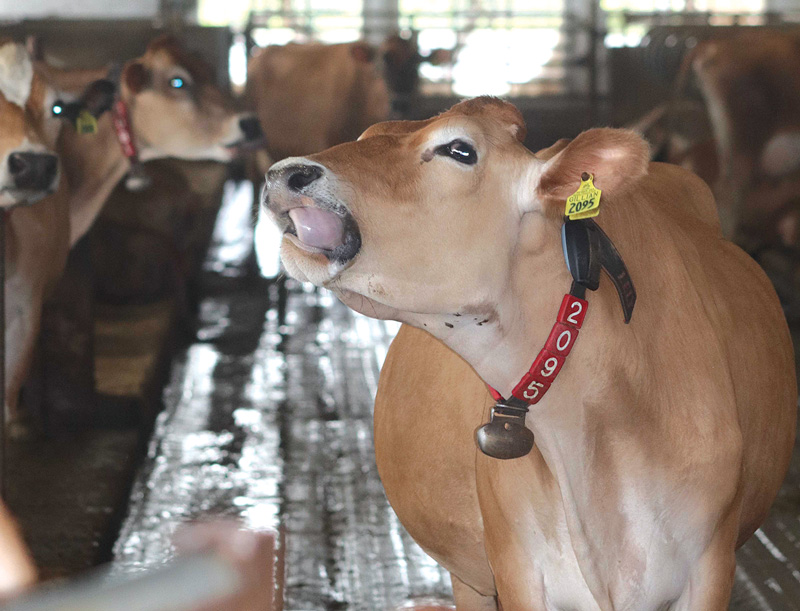
Cinnamon Ridge Dairy Farm, Donahue, IA
199 Lactations
Actual: 26,125M, 1,237F, 960P (first milk and protein, second fat)
ME: 25,509M, 1,242F, 962P (second milk and protein, sixth fat)
Cinnamon Ridge Dairy Farm is owned and operated by the Maxwell family.
We milk around 210 Jersey cows.
We sell some of our milk to Brewster Cheese in Stockton, Ill., where we earn premiums for fat, protein, other solids, and somatic cell count (SCC). We also use our milk to make Cheddar and Gouda cheeses at the farm. We sell them and Jersey beef, pork and eggs raised on the farm and home-baked goods through The Country Cupboard, our on-farm store. Our products are also available online and at several outlets in Iowa and Illinois.
We milk cows with four Lely robots and house them in sand bedded stalls. We built the barn in 2012 with tourism in mind, so the barn has windows to view the robots and overlook the cows in the barn. Promoting dairy and agriculture is a major emphasis of our business.
We feed our cows a partial mixed ration (PMR) at the feed bunk and pellet at the robotic milking station. The PMR mix includes ground corn, soybean meal, amino plus, mineral mix, cottonseed, baleage, corn silage, and water.
We use milk and component production as well as income over feed costs to determine profitability. We use DHIA production reports with herd averages as benchmarks.
Our three go-to tools are Lely T4C (herd management system), infoJersey.com (online access for American Jersey Cattle Association [AJCA] programs and services) and TMR Tracker (feed management software from Digi-Star).
Our ideal cow has high production and longevity.
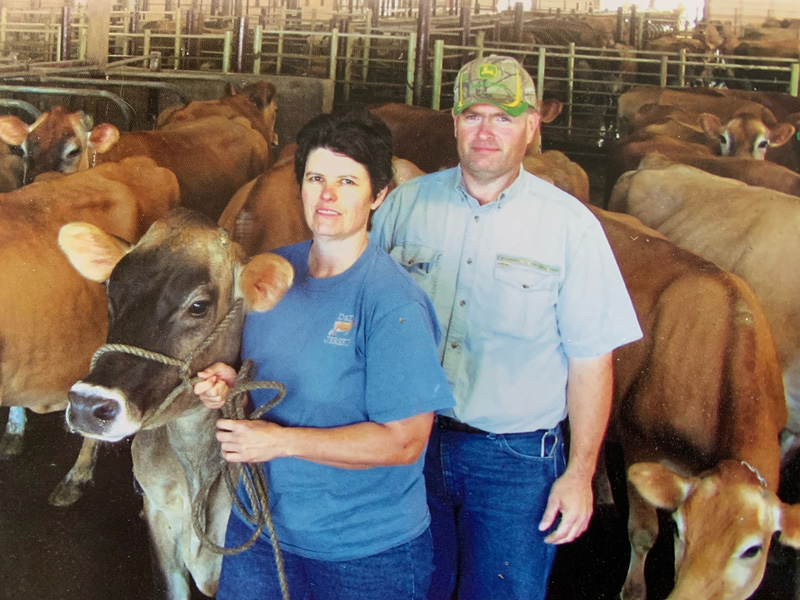
Donna Phillips and Dan Stock, top, and Emalee, bottom left, and Erica, bottom right, operate D & D Jerseys.
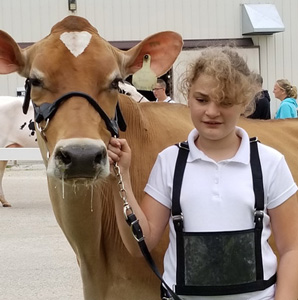
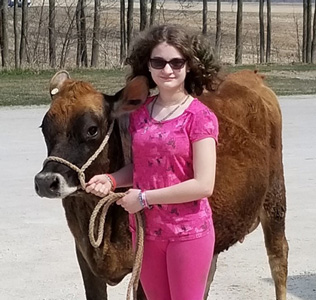
D & D Jerseys LLC, Newton, WI
69 Lactations
Actual: 22,291M, 1,110F, 796P (sixth milk, 10th fat, ninth protein)
ME: 24,868M, 1,231F, 893P (fifth milk, seventh fat, fifth protein)
D&D Jerseys is owned and operated by Donna Phillips and Dan Stock. Dan does the field work and feeding while Donna does the milking, mating, record keeping, and veterinary work. We have twin teenage daughters, Erica and Emalee, who also help out on the farm.
We milk 85 cows.
Our milk is shipped to BelGioioso Cheese Inc. We earn premiums for butterfat, protein, and low SCC and plate count.
We milk cows in a double-four herringbone parlor and house them in a freestall barn. The barn is tunnel ventilated, with partial curtains on the west side and fans on the east side. The curtains and fans are automatically operated to control temperature. The barn itself is a two-row setup with drive through feeding. Cow are divided into three different groups: two-year-olds; older cows; and fresh, high producers. The alleys are equipped with mats for cow comfort and alley scrappers that dump into a gravity flow reception pit. The sawdust-bedded stalls have mats as well.
We feed a total mixed ration (TMR) prepared with a vertical mixer. The mix is fairly straightforward, containing corn silage, baleage, and a grain mix of soybeans, soybean meal, cotton seed, and mineral among others.
We pay attention to all details on the farm, no matter how small, because they add up and all contribute to profitability. As well, we keep a finger on the pulse of what is going on in the dairy industry beyond our barn gate because this impacts profitability too.
The most important tools we use for herd management are infoJersey.com and genotyping.
I (Donna) am a bit of a perfectionist, so my ideal cow encompasses everything, from type to milk production to components. The ideal cow is a total package. I consider myself lucky to have owned and milked some Excellent, 30,000-pounds milk cows that have been close to this standard.

Jim and Tara Herron own and operate Cold Run Jerseys with their daughters, Ruby, Rose (with Tara) and Pearl. The Herrons have ranked among the country’s top producers for many years and milked many of the breed’s leading lifetime and 305-day record holders.
Cold Run Jerseys LLC, Salem, OH
198 Lactations
Actual: 20,889M, 1,080F, 787P (10th protein)
ME: 23,330M, 1,200F, 878P (seventh protein)
Cold Run Jerseys is owned by Jim and Tara Herron and operated as a limited liability corporation.
We currently milk 225 cows.
We market milk to Guggisberg Cheese in Sugar Creek, Ohio, and receive a protein bonus and quality bonuses for low SCC and bacteria count.
Our milk cows are housed in a four-row freestall barn with a drive-through feed alley with headlocks and cow mattresses bedded with sawdust. We milk in a double-10 parallel GEA parlor with an electronic milk metering system, which includes activity monitoring and SCC readings.
Our ration is a TMR that includes baleage, corn silage, dry hay, straw, and high moisture corn. We also add a supplement from Purina that consists of soybean meal, distiller’s grain, a mineral blend, tallow, and other additives. All forages and corn are grown on the farm. Our only purchase is the Purina supplement.
Most of the measures we use to determine profitability are primarily based on milk income over feed costs. Because feed costs are one of the largest expenses on our farm, we try to minimize costs by growing all our forages and contracting supplement and protein sources. Each year, we also set goals to improve milk production or components.
Our top three tools for management are: 1.) farm computer systems, which include PCDART, DairyPlan C21 (GEA herd management system), and transponders for activity; 2.) appraisals and pedigree information from the AJCA; and 3.) active presence on the farm each day.
Our ideal cow has exceptional type with an emphasis on feet and legs and udder composition, which gives her longevity and enables her to produce large quantities of high component milk into mature age.
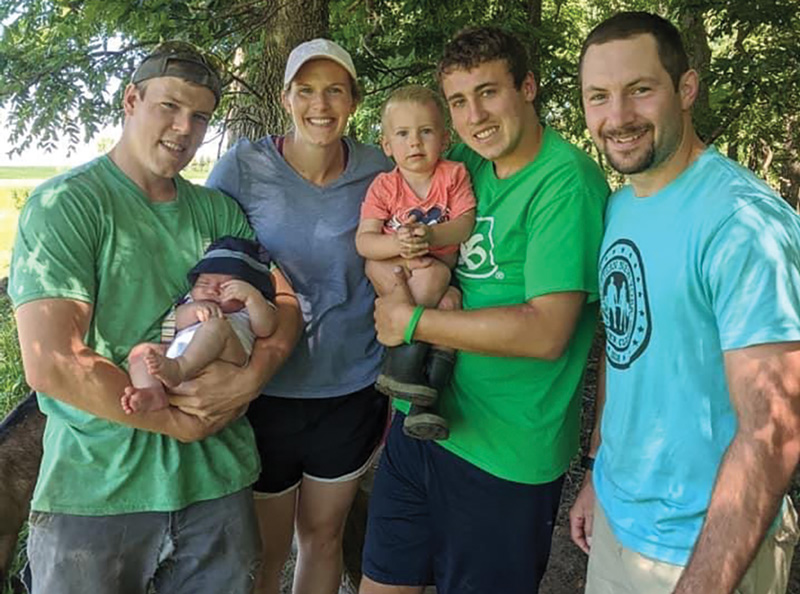
The Dicke Family has been farming in Red Wing, Minn., for more than 100 years and today milks a mixed herd of Holsteins and Jerseys. Pictured are Charlie, with nephew Landon Evans, left, and his brother Jay, with nephew Paxton Evans, center, and their sister, Ann and her husband, Joe Evans.
Ann, Charlie and Jay Dicke, Red Wing, MN
10 Lactations
Actual: 21,464M, 1,130F, 700P (sixth fat, eighth protein)
ME: 23,405M, 1,227F, 874P (ninth fat and protein)
Dicke Century Farm has been in our family for 113 years. My siblings, Jay and Ann, and I (Charlie) are the fifth generation to farm this land south of Minneapolis near the Mississippi River. Our parents are Lyle and Shannon Dicke. Over the years, we have gradually added animals and land to the business. Today we raise corn, soybeans, alfalfa, and peas and sweet corn for canning. We have been no tilling and cover cropping for about 10 years.
We milk a herd of 190 Holstein and 11 Jersey cows twice daily.
We ship milk to the First District Association in Litchfield, Minn., and use Dairy Margin Coverage for most of our milk.
Cows are milked in a double-nine parallel parlor and housed in a four-row, sand-bedded freestall barn with natural ventilation.
We feed our milk cows a ration that includes haylage, BMR corn silage, a little baleage, high moisture corn, a protein mix from Ag Partners and corn gluten pellets from ADM. We have fed this basic ration for quite some time and occasionally include dry hay or straw. Dry cows are fed haylage, baleage, straw and the protein mix.
Some benchmarks we consider as measures of profitability are income over feed cost and cost of production. We strive for solid components, excellent milk production and SCC under 100. I like to see third and higher lactation Holsteins averaging 140 lbs. milk a day and Jerseys peaking at 90 lbs. milk.
The three tools of most value to our operation are: CowManager (ear tag system from Select Sires Inc. in the U.S.) to identify sick cows and cows in heat; milk meters in the parlor to evaluate fresh cow performance and find sick cows; and genotyping to guide dairy sale decisions and semen selection.
Our ideal cow follows four stages: 1.) she has live calves, 2.) starts her lactation with no issues, 3.) breeds back easily, and 4.) leaves the farm in good condition. If the first three happen successfully, milk will come.
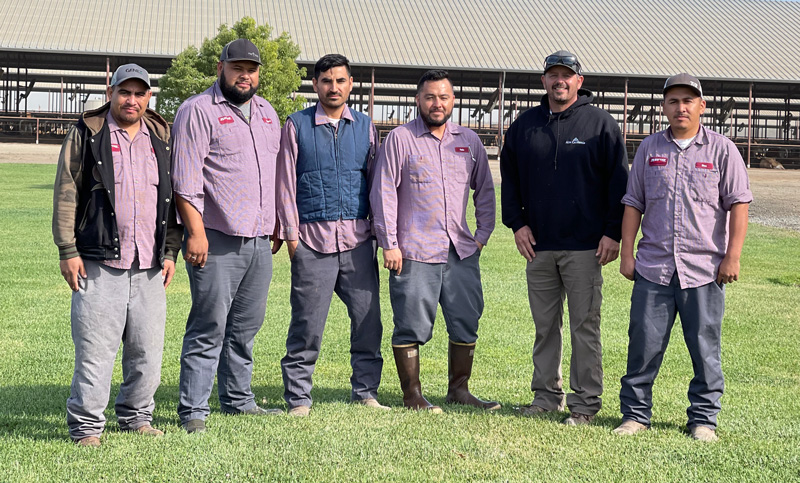
The team that cares for the Red Top Jerseys herd on a daily basis includes, left to right, herdsmen Victor Jimenez, Arturo Espinosa, and Valentin Perea, foreman Roberto Romo, manager Chris Terra, and herdsman Rene Romo.
Red Top Jerseys, Hilmar, CA
4,634 Lactations
Actual: 19,635M, 952F, 721P
ME: 23,810M, 1,134F, 869P (seventh milk)
JPI Herd Average: Ranked #12 in nation with JPI of +49 on 5,222 cows
Red Top Jerseys began milking in a new facility on April 2, 2007. The dairy is owned by Mike and Scott Wickstrom and Brad Nyman and managed by Chris Terra.
Red Top Jerseys milks 5,700 cows. Most are milked three times daily. However, a pen of fresh cows is milked four times a day and a few pens of pregnant cows are milked twice a day.
All milk is sold to and marketed by Hilmar Cheese. We earn quality incentives based on SCC, laboratory pasteurization count, standard plate count, and E-coli.
Cows are milked in twin 72-stall rotary parlors. They are housed in two-row, head-to-head freestall barns with drive through feed alleys. Each barn holds 1,280 cows divided among four pens. Composted, recycled manure is used for bedding.
We feed a typical west coast diet consisting of corn and wheat silages, alfalfa hay, and a combination of common commodities, such as rolled corn, whole cottonseed, canola, or soybean meal, among others. If price and availability allow, we feed a blend of calcium salts and palm oil as a fat source. Recently, though, the diet has only included the calcium salts.
Currently, the milking herd is fed one of four diets. About 75% of the herd receives a high-production diet. Three pens of pregnant two-year-olds (about 15% of the herd) receive an additional protein supplement to meet growth needs. A pen of mature cows (about 5% of the herd) nearing dry off are fed a pregnant diet. About 5% of the herd is fed a fresh cow diet. This is our most “technical” diet as it targets amino and fatty acids while promoting intake during the critical transition period. Fresh cows and heifers are milked four times a day and stay in the pen 10-15 days on average post calving. The percent of the herd fed the high or pregnant diet fluctuates, depending on herd dynamics and body conditions.
Our biggest driver of profitability is pounds of milk/cheese shipped, so all things correlated to production are emphasized. Because all things impact production, all are monitored. Obviously, the heavy hitters are reproduction, milk quality, and herd health. If these are in order, we are positioned to milk older cows. In turn, this increases production per stall and reduces the number of replacements that need to be fed and raised. This greatly impacts profitability. This is a generalized answer to a complex question because there are so many details that affect profitability.
The programs I (Chris) use to manage the herd are DairyComp and FeedWatch. Milk weights are recorded by DairyPlan C21 and then sent to DairyComp. I have also created a few Excel (Microsoft) spreadsheets to track production trends.
Unless she is something genetically special, the ideal cow on a large commercial dairy is the cow you do not know. She never comes up on a low production or reproduction list and is never in the hospital. Phenotypically, she is moderately sized with a balance of strength and dairy, has sound feet and legs and a good udder. She produces high component milk, gets bred back easily, and lasts for at least four lactations.
Vander Haak Dairy is owned and operated by Steve and Jewel Vander Haak.
We milk 500 cows: 400 Holsteins and 100 Jerseys.
Milk is sold to Darigold. We receive premiums based on both components and quality.
Cows are milked in a DeLaval double-12 parallel parlor three times daily and housed in freestalls. We bed freestalls with solids from our digester.
We feed a complete TMR that consists of corn silage, grass silage, alfalfa hay, and a complete grain mix. Our ration is balanced by an independent nutritionist.
We look at income over feed costs with the nutritionist and full financials with an accountant on a quarterly basis.
We use both DairyComp and FeedWatch from Valley Ag Software to manage cow health and feed and QuickBooks (Intuit) to manage finances.
We look for cows with great udders and sound feet and legs that produce adequate amounts of milk with high components. Our tests for the 2021 herd average (ME) were 6.2% fat and 3.75% protein.
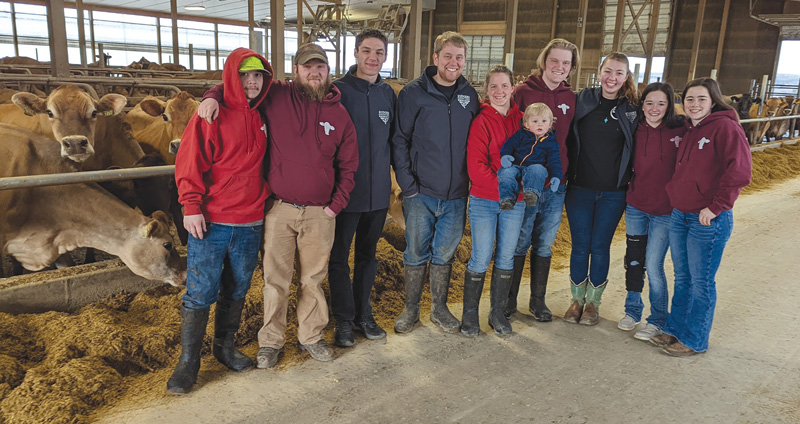
Lyman and Chelsey Rudgers (holding their son Andrew), center, operate Rudgers Jerseys with his brother, Tracy, fourth right, and other members of the family, including, Dustin Capwell, Nathan Burry, and Nicholas Downs, left, and Sorrell Brown, Marina Cox, and Sarah Cox, right.
Rudgers Registered Jerseys, Attica, NY
173 Lactations
Actual: 21,640M, 1,017F, 773P (10th fat)
ME: 21,959M, 1,061F, 802P
Rudgers Registered Jerseys is owned and operated by Lyman and Chelsey Rudgers with help from both of their families. Her parents own the facilities but are working on a plan to transition ownership to the couple.
We milk 290 cows, almost entirely Registered Jerseys.
All milk is marketed through Westco Milk Producers Cooperative and processed at Sorrento-Lactalis. We earn quality premiums for having a SCC less than 125,000 cells/ml. Our average for 2021 was 76,000. We earn a protein premium for protein over 3.1%. Our AJCA actual herd averages for 2021 are 4.7% fat and 3.57% protein.
We house cows in two, six-row freestall barns that are bedded with sand. Dry cows, pregnant heifers, and first lactation heifers are housed in the original barn, which has a center, drive-through manger. Mature cows are housed in a freestall barn we built in 2018. This barn is equipped with alley scrapers and two perimeter feed alleys in anticipation of switching to robotic milkers in the future. We milk all cows three times a day in a rapid-exit, double-10 parallel homemade parlor.
We feed a very basic single TMR to the milking cows that consists largely of BMR corn silage, haylage and triticale, molasses, and a complete dairy mix. We add water to it to achieve 48% dry matter. Dry cows are fed one diet from dry off to calving. This diet is a “goldilocks diet” made of straw, corn silage, grain with anionic salt, and water.
We focus primarily on pounds of components per cow as a measure of profitability. We also use Farm Credit’s Dairy Profit Analyzer to benchmark our dairy with other dairies in our area.
We use sire conception rate to evaluate reproduction, SCR for reproduction, Lely Juno feed pushers in each barn to make sure cows always have feed in front of them, and DairyComp 305 for record keeping.
Our ideal cow is a functional-uddered cow who breeds back on the first service while making 7-plus pounds of solids each day—basically the typical Jersey.
Sand Creek Dairy has been operated by six generations of our family in Hastings, Mich., over 115 years. Today, the business is operated as a partnership by the fourth generation, Larry and Ellen, fifth generation, Luke and Renee, and sixth generation, Ethan, Austin and Devin.
We are milking 330 Jerseys in a herd of 1,200 cows.
We are members of Prairie Farms Cooperative and ship our milk to the plant in Battle Creek, Mich. We earn premiums for low SCC and low preliminary incubation count.
Our herd is housed in six, four-row freestall barns bedded with recycled sand. Cows are milking in one of two parlors: a double-20 parallel parlor or a double-six parallel hospital parlor.
Our TMR is based on high quality forages. The primary components are BMR corn silage and low lignin alfalfa haylage. We balance the ration with high moisture corn, ground corn, gluten, wheat midds, canola meal, distillers grain, soybean meal, and mineral. We raise all our own forages and corn grain with a focus on feed quality and digestibility.
Profit revolves around managing our herd to full potential. In addition to solids production, we continually monitor reproductive performance through conception and heat detection rates. We work with Michigan State University extension to evaluate our farm financial scorecard and work closely with our accountant and lender.
Technology is our go-to farm management tool. We utilize Afi for heat detection and cow identification in the parlor and rumination collars to identify sick cows. We also use PCDart to manage protocols, record events, and keep cows on track for a successful lactation.
Another key tool for our herd is genomic testing. We genotype every calf at birth to identify males with potential to enter AI service and females most valuable to raise. This information flows into our IVF-ET program. We use the bottom half of heifers and first lactation cows as recipient animals for our higher genetic value livestock.
People are the other key to the success of our farm. We have a diverse management team with different experiences, and also work closely every day with our nutritionist, veterinarian, calf consultant, accountant, cropping consultant, MSU extension and industry experts. These advisors see many things on other farms and can provide objective advice. We are never afraid to try something new, and continually strive to improve our herd and operation.
Our breeding program strives to make cows like SANDCREEKS CRITIC CHIPSTER-P-ET, who has a best record of 27,930M, 1,466F and 1,049P, is appraised Excellent-93%, and has numerous offspring on the list of the Top 500 Females for GJPI. Today, she has five male descendants in active AI service, 11 female descendants ranked among the top 1.5% for genetic merit, and many other profitable descendants in the milking herd. We continue to try to breed more males and females like Chipster-P, who epitomizes our goals for top production, dense milk, functional type and good fertility.
